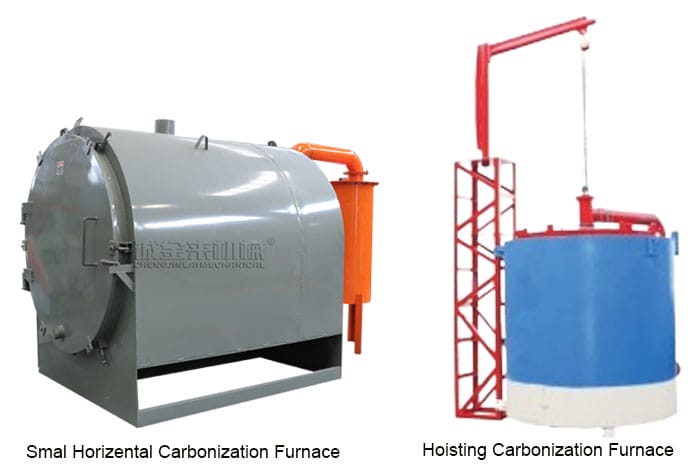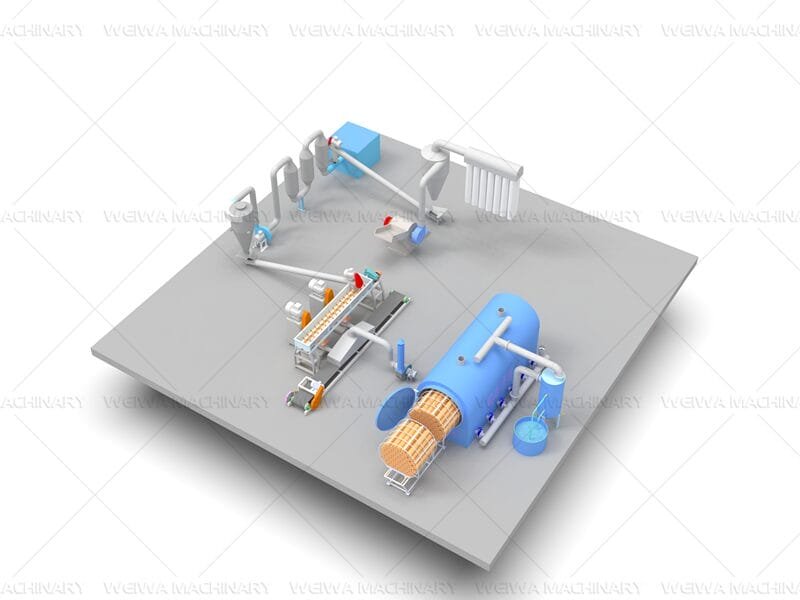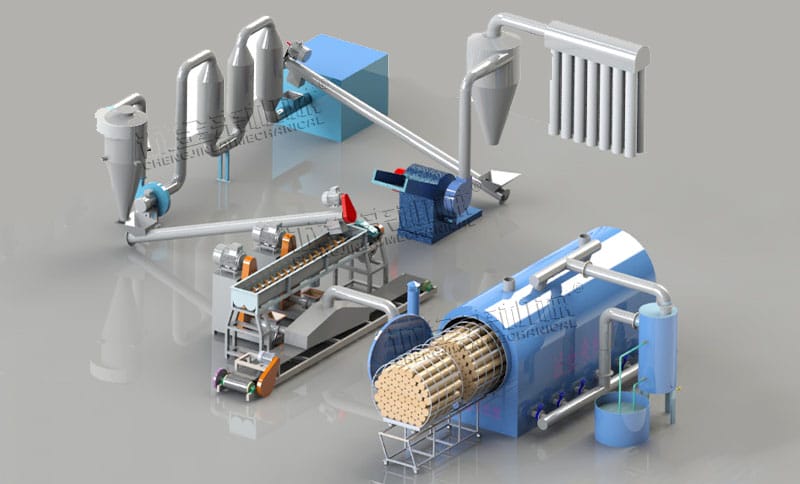Small charcoal making machine is suitable for those who want to engage in this business or have a limited budget for small-scale charcoal processing business. You only need to configure a horizontal carbonization furnace or a hoisting carbonization furnace to realize the carbonization of native wood, bamboo, coconut shells, etc. From the above carbonization furnace you can get the nature charcoal without any manual intervention. This is the lowest cost charcoal processing business on the market.

Small charcoal making machine production line can processes rice husk / sawdust ect crushed biomass materials into charcoal, our Small charcoal making machine production line can processs wood lod, coconut shell ect large bulk materials through crushing, drying, rod making and carbonization. This compact charcoal production line is designed for small enterprises, which can provide high-quality output, easy operation, and second low investment cost.

The small charcoal making production line consists of several interconnected stages, which work together to convert biomass materials into valuable charcoal. Here’s the basic flow of the process:
Raw Material Collection → Grinder → Airflow Dryer →Charcoal Rod Making Machine→ Hoisting Carbonization Furnace → Finished Charcoal
Each stage in this process plays a crucial role in ensuring the charcoal produced is of high quality. The materials move seamlessly from one stage to the next, ensuring consistent output.

1. Raw Material Collection
The first step in the charcoal production process is the collection of raw materials. These materials are typically biomass sources such as wood, coconut shells, rice husks, sawdust, or agricultural waste. The raw materials must be gathered and prepared for further processing.
- Purpose: Gather suitable biomass materials for the next steps of production.
- Equipment: Generally, no specific machinery is needed here, but raw materials are collected from sources like local farms, wood mills, or plantations.
2. Grinder (Crushing Machine)
Once the raw materials are collected, they need to be processed into smaller pieces to increase the surface area for drying and carbonization. This is where the grinder (also called the crushing machine) comes into play.
- Purpose: Reduce the size of large raw materials into smaller, more manageable pieces.
- Equipment: Wood crusher or biomass grinder.
- This crushing machine is designed to break down logs, branches, and other bulky biomass into smaller pieces, typically 3-5 cm in size. The smaller size facilitates easier drying and ensures uniform carbonization, which leads to a better-quality final product.
3. Airflow Dryer
After grinding, the raw materials need to be dried to reduce their moisture content. Excess moisture in the raw materials can hinder the carbonization process, reducing the quality of the charcoal. The airflow dryer is used to remove moisture effectively and efficiently.
- Purpose: Dry the biomass material to the required moisture level (usually below 20%).
- Equipment: Airflow dryer.
- The airflow dryer uses hot air to blow through the raw materials, rapidly reducing the moisture content. It is energy-efficient as it often utilizes heat generated from the carbonization furnace in the next stage, lowering overall energy consumption.
4. Charcoal Rod Making Machine
Once the raw materials are sufficiently dried, they are ready for further processing into a usable form. The charcoal rod making machine takes carbonized raw materials (or charcoal powder) and shapes them into charcoal rods.
- Purpose: Compress the carbonized biomass or charcoal powder into rod-shaped forms.
- Equipment: Charcoal rod making machine.
- This machine uses pressure and heat to mold charcoal powder or fine particles into compact, uniform charcoal rods. The pressure ensures that the final product is dense, improving its burning efficiency. Charcoal rods are highly sought after for use in grills, barbecues, and industrial heating due to their compact size, uniformity, and higher energy density.
5. Carbonization Furnace
After the materials are processed into charcoal rods, the next step involves carbonization, where biomass is heated in a low-oxygen environment to produce charcoal. The carbonization furnace is essential for this step.
- Purpose: Heat the biomass material (or pre-processed charcoal) in a low-oxygen environment to convert it into charcoal.
- Equipment: Hoisting carbonization furnace
- The hoisting furnace is designed to provide precise control over the carbonization process. It uses high temperatures (usually 400-600°C) and limits oxygen to produce charcoal. This furnace is equipped with a hoisting system that allows for easy unloading of the charcoal after it has been fully carbonized. This hoisting feature improves efficiency and reduces the need for manual labor during the extraction process.
- Purpose: The horizontal carbonization furnace is another widely used device in charcoal production, also designed to heat biomass material at high temperatures while controlling oxygen levels to ensure proper carbonization.
- Equipment:Horizontal Carbonization Furnace
- Unlike the hoisting furnace, the horizontal carbonization furnace features a horizontal layout where biomass materials are continuously fed into the furnace and undergo the carbonization process.
6. Finished Charcoal (Cooling & Packaging)
Once the charcoal is carbonized and processed into rods, it must be cooled before packaging for sale. The finished charcoal then undergoes final preparation to ensure it meets quality standards.
- Purpose: Cool the charcoal, sieve it for uniform size, and prepare it for sale.
- Equipment: Cooling machine and sieving machine.
- The cooling machine is used to lower the temperature of the charcoal to a safe handling level. Once cooled, the sieving machine ensures that the charcoal is separated into uniform sizes for market standards. The final product is then packaged for distribution.
Here is the small charcoal making machien youtube video working process in our factory for your reference!!
Small Cahrcoal Making Machine Features
The small charcoal making machine offers several advantages for businesses looking to invest in an efficient and cost-effective production process.
- High Efficiency: The small charcoal making production line significantly reduces production time compared to traditional methods. The continuous carbonization process ensures that raw materials are processed efficiently, leading to a higher output in less time.
- Energy Saving: This equipment is designed to be energy-efficient. It utilizes waste heat generated during the carbonization process, which is then used to fuel the dryer and reduce energy consumption, lowering overall operating costs.
- Eco-Friendly: By using agricultural waste and biomass materials, this machine helps reduce the amount of waste that would otherwise be discarded. This makes the small charcoal making production line an environmentally friendly option for producing charcoal.
Small Charcoal Making Equipment Benefits
- Sustainability: Reduces reliance on fossil fuels and promotes eco-friendly practices.
- Increased Profitability: Turns low-cost biomass into high-value charcoal, boosting revenue.
- Versatility: Can process various biomass materials, including wood, coconut shells, and agricultural waste.
The Small Charcoal Making Machine Production Line is a powerful and eco-friendly solution for producing high-quality charcoal. Its advanced features, high efficiency, and low operational costs make it a smart investment for small to medium-sized businesses. Whether you’re producing charcoal for local use or exploring new markets, this production line offers high efficiency, consistent quality, and low operational costs.
By investing in the Small Charcoal Making Production Line, you can improve efficiency, reduce costs, and contribute to environmental sustainability.Welcome to contact us freely online to get 100% free quotations!!





 Wechat
Wechat

